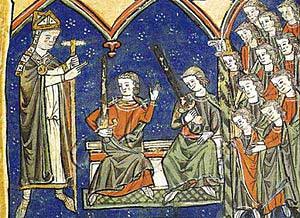When learning about the History of Santiago de Compostela there is one man that regularly comes up as the saviour, historian, architect and politician that made this city possible. We are of course talking about Diego Gelmírez or Xelmírez (Latin Didacus Gelmirici) (ca 1069 – ca 1149) who was the second bishop (from 1100) and the first archbishop (from 1120) of the Roman Catholic Archdiocese of Santiago de Compostela.

He is a prominent figure in the history of Galicia and an important historiographer of the Iberia of his day. Diego involved himself in many quarrels, ecclesiastical and secular, which were recounted in the Historia Compostelana, which covered his episcopacy from 1100 to 1139 and serves as a sort of gesta of the bishop’s life.
The Archbishop Don Diego Xelmírez Legendary Life
Santiago’s History will remember his political instinct and political intelligence that allowed him to raise to power and prevent further destruction of his beloved city and cathedral. He worked to enlarge the cathedral’s building size but also its power, reorganised the city, helped defend the population from the Norman and Viking aggressions by organising the first fleet of ships in Christian Spain and permitted the creation of the Camino de Santiago as pilgrims knew it centuries later.
Xelmírez early life
He was probably born in the Galician coastal town of Catoira, 40km from Santiago, where his father, Gelmiro or Xelmirio, was the custodian of the castle Torres do Oeste. He received an education at the court of Alfonso VI of Castile.
He began his career as a tutor to Alfonso VII the son of Doña Urraca who later became king of Galicia and then in the year 1126 Emperor of Castille and León.
In 1090, he was made Chancellor, three years later administrator of the diocese and in the year 1101, on the instructions of Pope Pascual II, the first Bishop of Santiago.
Xelmírez as Archbishop of Santiago de Compostela
In 1120, Pope Callixtus II elevated Diego to archiepiscopal rank and appointed him papal legate to Spain. That same year, according to the Historia, Urraca ordered the leading men (principes) of Galicia, including Arias Pérez, to do homage (hominium) to Diego Xelmírez as “their lord, their patron, their king and their prince, saving their fealty to the queen” and recognise his rule (dominio).
The next year however, after Diego had renewed his alliance with Pedro Fróilaz de Traba, his power appeared to threaten by the queen. In the summer of 1121, she had Diego arrested at Castrelo in collaboration with Arias Pérez. Diego was imprisoned for a while, but the support of the people, which he had been cultivating, compelled his release.
Not surprisingly, on this extraordinary rise to power, he had to overcome many obstacles, one of which was a mob setting fire to the Cathedral.
Xelmírez impact on the Santiago de Compostela we know and love today
In 1136, the wealthy middle-classes refused to pay their taxes. Through a combination of firmness and his mastery of diplomacy, he cleverly overcame all the impediments put his way. Thanks to his initiative and ambition, the face of Santiago changed radically.

Xelmírez built new streets, laid drains and constructed churches and many important buildings. Being conscious of the religious and economic importance of the Camino de Santiago, he not only increased the military presence along its route but also personally oversaw the construction of albergues and shelters along the Way.
He also encouraged the establishment of guilds, the first of which was that of the “cambeadores” who changed foreign currency into the legal tender of the time in Compostela. The currency was minted by himself by royal decree.
This man was definitely one of the most prominent figures in the History of our beloved city. With his writings, he gave us a real insight about life in the XI-XIIth century but although we know almost everything about his life and his work, it is interesting to note we have absolutely no information about his last years nor the place or date of his death.